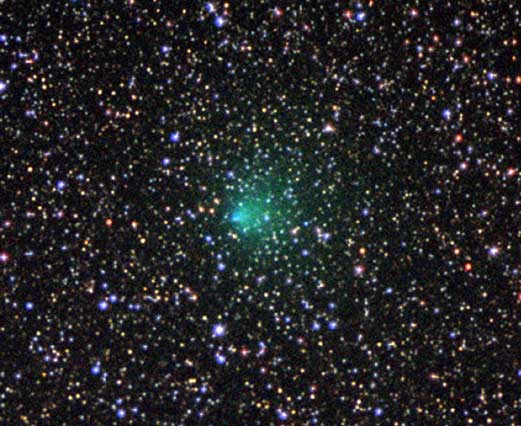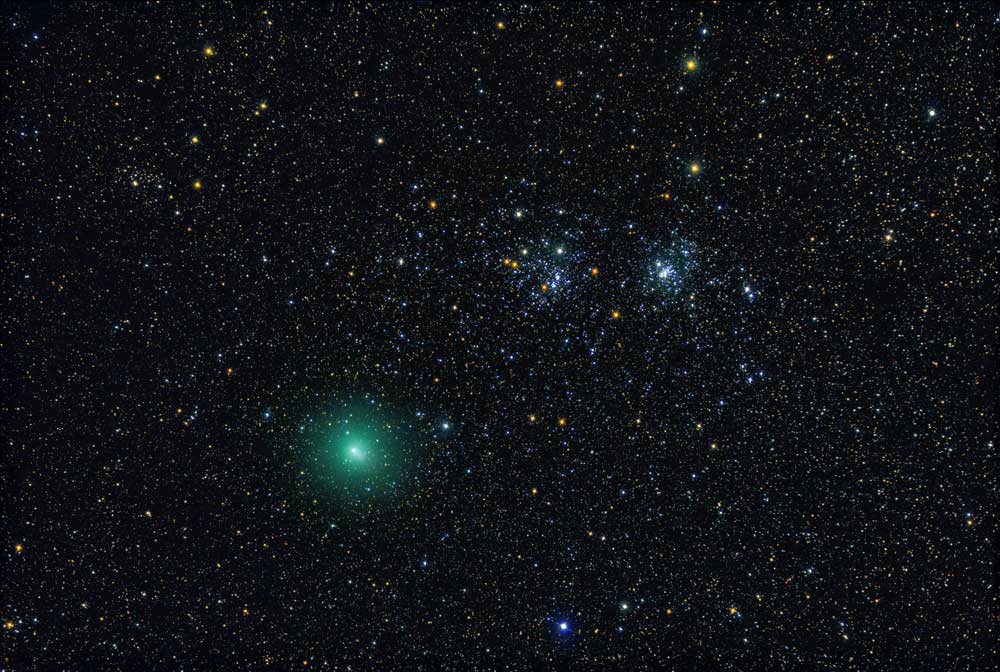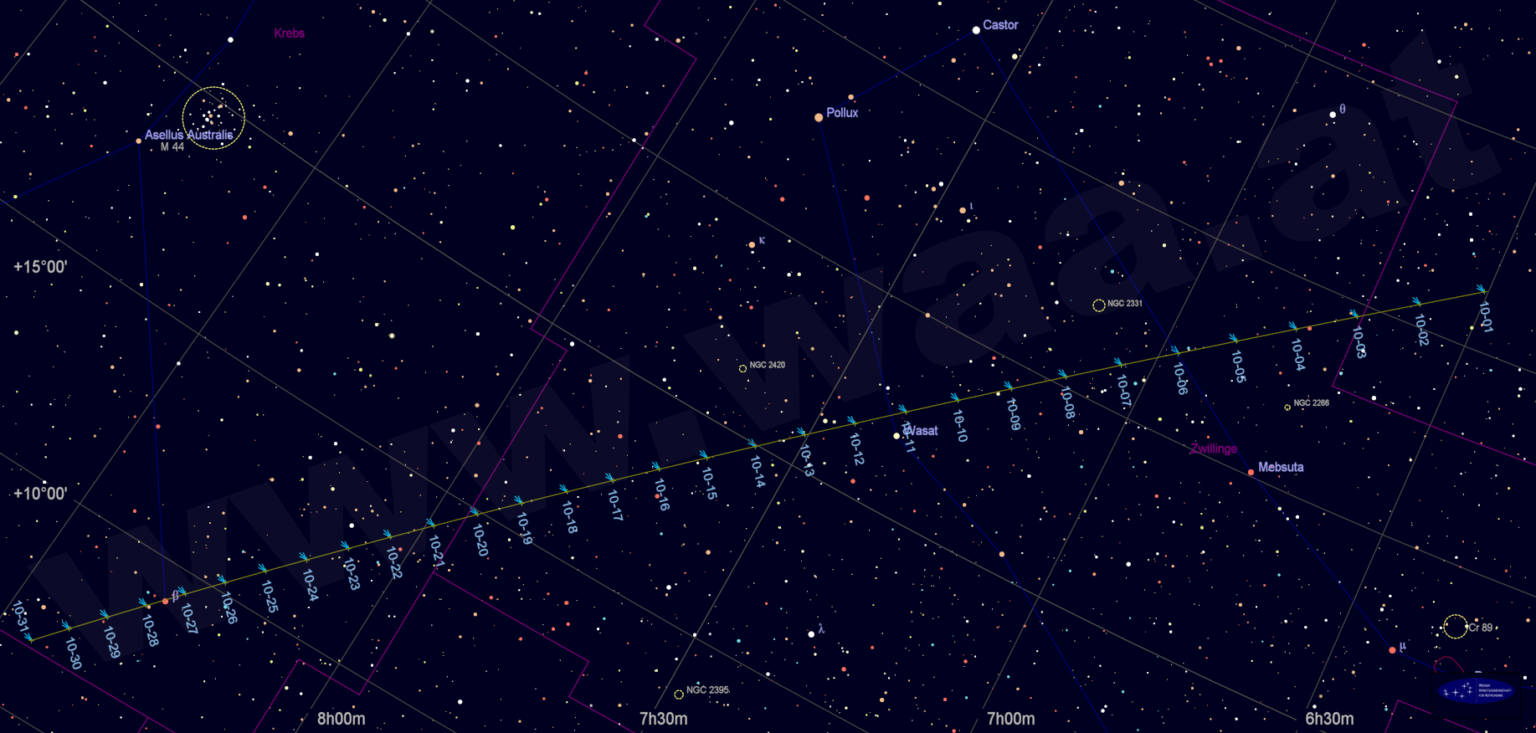The recently discovered comet Nishimura disappeared into the sun’s rays in mid-September and became inaccessible to observers of the Northern Hemisphere to return in 435 years. But this does not mean that the autumn sky is left without “tailed stars”. In fact, there are now two objects of this class on the celestial sphere that can be seen with small amateur telescopes. These are Comet Encke and Comet Hartley 2. The last of them was discovered in 1986, and the first has been known to mankind since the end of the XVIII century.
Long history of Comet No. 2
The first comet Encke, which was not yet so called, was seen on January 17, 1786 by the French astronomer Pierre Méchain. During its return in 1795, it was found by Caroline Herschel, the sister of the famous English scientist William Herschel. In 1805, another Frenchman was involved in the discovery of this “tailed star” — the famous “comet hunter” of the century before last, Jean-Louis Pons. That year, it was first observed with the naked eye. In 1819, German astronomer Johann Franz Encke finally “connected” all the known appearances of this body and proved that it really was the same comet with a period of 3 years and 4 months (more precisely, 1205 days), which should return in 1822. The scientist’s prediction came true — by the way, for the second time in the history of astronomy. Therefore, in cometary catalogs, this object has the number 2 with the index “P”, which means “periodic” (2P/Encke). At number 1, there is the famous Halley’s Comet.
Comet Encke has the shortest orbital period among all celestial bodies that consistently demonstrate cometary activity. Of course, with such frequent returns to the inner regions of the Solar System and perihelion near the orbit of Mercury, its core gets very hot and constantly loses large volumes of volatile substances responsible for the formation of the coma and tail. Therefore, the absolute brilliance of the comet, which it would have at a distance of 1 au from the Sun and the observer, is gradually decreasing. With the naked eye, it was last seen in July 1997, during the closest approach to our planet in history. But then it was observed only in the Southern Hemisphere.

In the autumn of this year, the visibility conditions of comet Encke are not developing in the best way. In early September, at the beginning of the morning astronomical twilight at the latitude of Kyiv, it managed to rise above the horizon by 40°, but its brightness at that time did not exceed the 12th magnitude, so instruments with a lens diameter of at least 15 cm were required for observations. In addition, at this time, the night sky was strongly illuminated by the Moon. On September 9, its sickle turned out to be 8° from 2P/Encke, and on the 12th, it passed at a distance of 50 arcminutes from Castor, the second-brightest star in the constellation Gemini. Around the same days, its brightness reached the 11th magnitude, and amateur astronomers began to actively observe the “tailed star”. Some recent estimates give it a shine near 10ᵐ. But by the beginning of twilight, the comet is rising barely 30° above the horizon.
On September 24, 2P/Encke will pass at 0.901 AU (135 million km) from Earth — this will be the closest approach to it in its current appearance. Its brightness is expected to increase to 9ᵐ. At this time, it will be approximately one degree from the star κ Leo. On September 28, the comet will be a degree south of ε Leo, and two days later — 12 degrees from Venus. However, at this time, its observations will again interfere with the Moon. Finally, on the morning of October 1, it will become brighter by 8ᵐ. On this day, it will be possible to see it to a degree from the bright star Algieba (γ Leo), at the beginning of astronomical twilight, it will still rise to 18° above the horizon. But in the future, the conditions of its visibility will deteriorate sharply, despite the fact that the brightness of the comet will reach the 6th magnitude. On October 12, the sickle of the old moon will pass near it again, and a few days later it will finally disappear in the sun’s rays. It will pass perihelion on October 22. Its next appearance will take place in 2027.
Comet Hartley 2 — Near and far
On September 26, two days after Comet Encke, Comet Hartley 2 will approach the Earth. The distance to it will be much smaller, at 0.383 AU (57 million km). It is expected that its brilliance at this time will exceed the 8th magnitude.
English astronomer Malcolm Hartley is involved in the discovery of 10 comets and three asteroids. He spent most of his scientific career at the Australian Siding Spring Observatory, where on March 15, 1986, he noticed his second “sole” periodic comet, which received his name with index 2 and the catalog designation 103P/Hartley. Calculations have shown that it orbits the Sun with a period of no more than 6 years and can approach it at a distance of 0.95 AU (142 million km). Moreover, near the perihelion, this celestial body passes very close to the earth’s orbit, which means that it can potentially closely approach our planet.

This is exactly what happened in October 2010, when the distance between 103P/Hartley and the Earth decreased to 0.121 AU. (18 million km). This happened in October 2010, when the distance between 103P/Hartley and the Earth decreased to 0.121 AU (18 million km). Then, in the conditions of a dark, unlit sky, the comet could be seen with the naked eye, and with small binoculars, it looked like a round greenish nebula, inside which a near-nuclear condensation and a small tail were visible. However, by that time, the comet’s orbit had noticeably changed under the influence of the gravity of the planets, and its perihelion lay already outside the Earth’s orbit. But it was still the closest approach to comet Hartley in the XXI century.
On November 4, 2010, the Deep Impact spacecraft flew 700 km from the core of 103P/Hartley and conducted detailed studies of it as part of the EPOXY mission. Thanks to this, we now have fairly detailed images of it and know that it resembles a 2.3 km long dumbbell in shape.

In mid-September 2023, the total gloss of 103P/Hartley exceeded the 10th magnitude, and it became available to small amateur instruments. However, its observations require care and a dark sky: the comet looks like a large nebula with low surface brightness. The slightest flare or light haze can make the search in vain. On the day of maximum approach to the Earth, the “tailed guest” will be 2° south of the star θ Aurigae and will move southwest at a speed of 1.5° per day.

In the following days, the comet will move away from the Earth, but will continue to approach the Sun, due to which its brightness will increase a little more. Perhaps it will have a rather expressive tail. It will pass perihelion on October 12. On this day, it will not be difficult to find it before dawn about a degree east of the star Vasat (δ Gemini). Further, the conditions for observing this celestial body will only worsen: its brilliance will begin to fall rapidly and in mid-November it will become less than 11ᵐ. We will see Comet Hartley 2 again in 2030.
By the way, the “double” Taurid meteor shower observed in early November is associated with comet Encke. It was formed when the comet’s orbit was closer to the earth.
Follow us on Twitter to get the most interesting space news in time
https://twitter.com/ust_magazine
